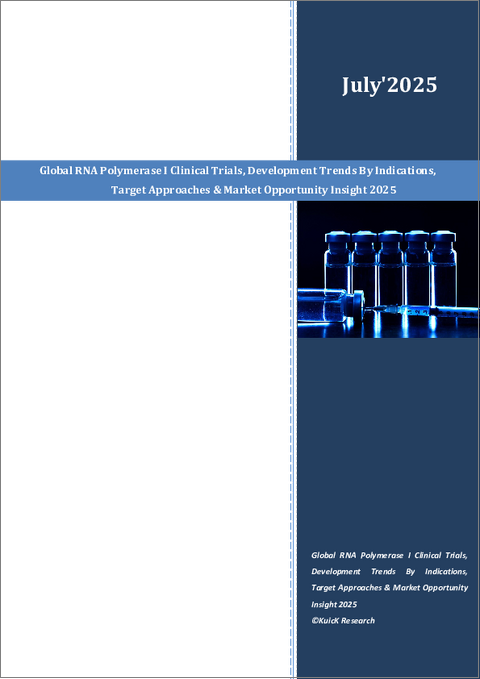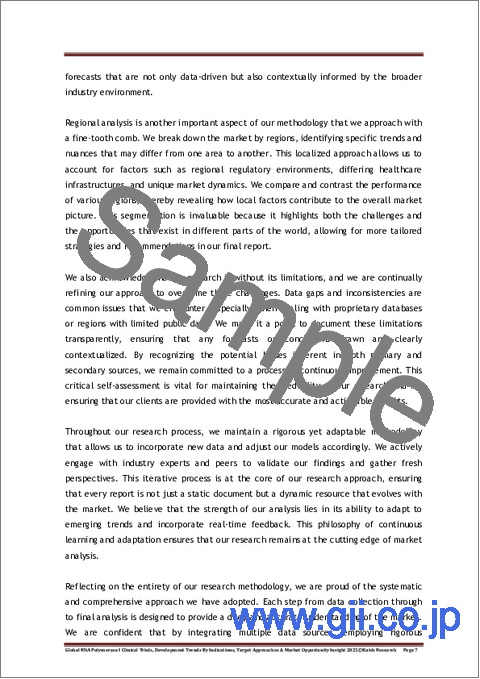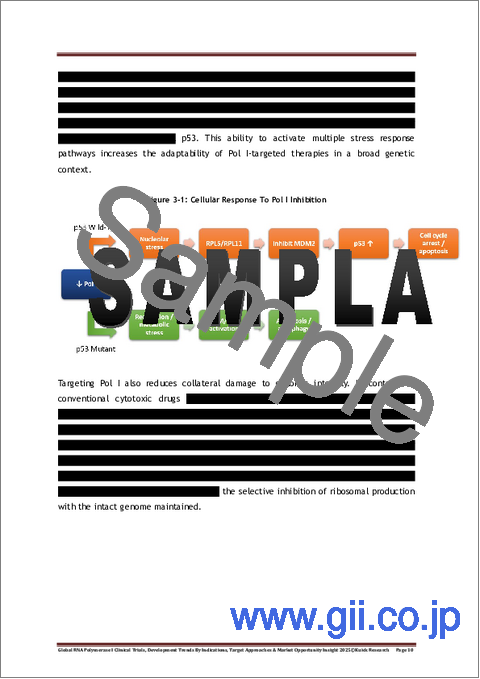|
|
市場調査レポート
商品コード
1774045
RNAポリメラーゼIの世界市場:臨床試験、適応症別開発動向、標的アプローチ、市場の機会(2025年)Global RNA Polymerase I Clinical Trials, Development Trends By Indications, Target Approaches & Market Opportunity Insight 2025 |
||||||
|
|||||||
| RNAポリメラーゼIの世界市場:臨床試験、適応症別開発動向、標的アプローチ、市場の機会(2025年) |
|
出版日: 2025年07月01日
発行: KuicK Research
ページ情報: 英文 60 Pages
納期: 即日から翌営業日
|
全表示
- 概要
- 図表
- 目次
「RNAポリメラーゼIの世界市場:臨床試験、適応症別開発動向、標的アプローチ、市場の機会(2025年)」レポートハイライトと調査結果
- 調査手法
- RNAポリメラーゼIを標的とする臨床アプローチ
- 適応症別のRNAポリメラーゼI阻害と臨床動向
- RNAポリメラーゼI阻害剤の臨床試験インサイト:企業別、国別、適応症別、相別
- 現在の市場シナリオと将来の機会
- 競合情勢
RNA Pol I阻害剤の必要性と当レポートの意義
リボソーム生合成に依存するがん、特にMYC過剰発現、相同組換え欠損(HRD)、p53経路の変化を伴うがんを標的とする臨床需要が満たされていないため、RNAポリメラーゼI(Pol I)阻害剤のニーズがあります。Pol iはリボソームRNA(rRNA)の転写を触媒し、リボソーム生合成の重要なステップですが、がんの大部分では過剰に活性化され、急速な成長を可能にしています。このリボソーム生合成へのがん特異的依存性は、RNA Pol I阻害剤が標的とする機会の窓を提供します。シグナル伝達経路やDNA複製を標的とする多くの治療法とは対照的に、Pol I阻害剤は、タンパク質合成という基本的な細胞内プロセスを阻害することによって、新たな戦略を構成します。
この報告では、特に直接的なRNAポリメラーゼI阻害剤に焦点を当てます。RNAポリメラーゼIを阻害する方法としては、直接的なものと間接的なもの両方が挙げられていますが、RNAポリメラーゼIを直接標的とする候補物質についてのみ詳しく述べています。また、ポリファーマコロジーの考え方にも触れましたが、RNA Pol Iに対して主要かつ選択的な効果を持つ化合物のみを本報告書に掲載しました。
当レポートの目的は、最新の科学的進歩を記録し、臨床パイプラインの進捗状況をプロットし、このハイリスク・ハイリターンのオンコロジー領域に関心のある投資家のために、将来の商業的・臨床的展望を強調することです。
当レポートに含まれる臨床試験の洞察
臨床的に最も進歩したRNAポリメラーゼI(Pol I)阻害剤はピンドナルレックス(CX-5461)で、元々はピーター・マッカラムがんセンターで開発されました。ピンドナルレックスは、リボソームDNA(rDNA)の転写を選択的に阻害し、G-四重鎖構造を安定化させることにより、複製ストレスとDNA損傷反応の活性化をもたらします。この薬剤は、複数のがん種における臨床試験で概念実証の有効性を示し、TP53野生型および変異型腫瘍の両方において抗腫瘍活性を示すとともに、管理可能な安全性プロファイルを示しました。これらの有望な結果に基づき、FDAは本薬の開発を促進するための特別な規制指定を行っています。
当レポートにこれらの洞察を盛り込むことで、学術的、商業的に重要な最新情報を提供することができます。
RNA Pol I阻害剤の研究開発に関わる主要企業
RNAポリメラーゼI(Pol I)阻害剤市場はまだ初期段階にあり、少数の戦略的企業や学術機関が市場開拓を主導しています。CX-5461は依然として有力候補であり、当初はPeter MacCallum Cancer Centreで開発されましたが、現在はSenhwa Biosciencesがテキサス大学MD Anderson Cancer Centerなどの主要機関と共同で開発を進めています。現在までに承認されたRNA Pol I阻害剤はありませんが、競合情勢は徐々に形成されつつあります。調査はまた、他のリボソーム生合成阻害剤や、Pol I阻害の非遺伝毒性メカニズムを提供するセンペルビリンのような天然物など、隣接する分野にも拡大しています。
RNA Pol I阻害剤セグメントの今後の方向性を示す報告書
RNA Pol I阻害剤の未来は明るいですが、それは決定的な開発のハードルを乗り越えられるかどうかにかかっています。毒性、特にPindnarulex試験で指摘された光毒性は、依然として用量制限要因となっています。患者選択に役立つバイオマーカーの必要性も優先課題です。HRDの状態、MYCの増幅、rDNAのコピー数の変化などが現在評価されていますが、日常臨床に使えるバイオマーカーとしてはまだ確立されていません。しかし、PMR-116のような毒性プロファイルがより明確で、連続投与が可能な新しい候補薬は、これらの問題を解決する可能性を秘めています。今後の開発では、POL i阻害剤とPARP阻害剤、トポイソメラーゼ阻害剤、あるいは免疫療法などとの併用レジメンが、合成致死性を利用し、耐性を回避するために有効になるとみられています。
当レポートは、固形がんのみならず血液悪性腫瘍においても、Pol I阻害の治療効果を最大限に発揮させるために、バイオマーカー指向の戦略、個別化された投与スケジュール、トランスレーショナル・トライアル・デザインの必要性を強調しています。
目次
第1章 調査手法
第2章 RNAポリメラーゼIのイントロダクション
- RNAポリメラーゼIの概要と生物学的役割
- 腫瘍形成における核小体ストレスとリボソーム生合成の重要性
第3章 RNAポリメラーゼIを標的とするメカニズムの基礎
- RNAポリメラーゼIを標的とする根拠
- 直接的なPol I阻害と間接的な調節
第4章 RNAポリメラーゼIを標的とするアプローチ
- 低分子阻害剤
- 多剤併用療法
第5章 RNAポリメラーゼI阻害の対象となる疾患領域
- 腫瘍学
- 造血悪性腫瘍
- 固形腫瘍
- 新たな適応症
第6章 RNAポリメラーゼI阻害剤の臨床試験:企業、国、適応症、相別
- 研究
- 第I相
- 第II相
第7章 RNAポリメラーゼI阻害剤の世界市場概要
- 現在の市場シナリオ
- 将来の研究開発と商業機会
第8章 RNAポリメラーゼI阻害剤市場力学
- 促進要因と機会
- 課題と抑制要因
第9章 競合情勢
- Pimera
- Senhwa Biosciences
List of Figures
- Figure 2-1: RNA Pol I Transcription & rRNA Processing Pathway
- Figure 2-2: Regulation of RNA Pol I Transcription
- Figure 2-3: RNA Pol I Activity During Cell Cycle
- Figure 2-4: Nucleolar Stress & p53 Activation
- Figure 2-5: Pol I - Therapeutic Inhibition in Cancer
- Figure 2-6: CX-5461 & BMH-21 - Mechanisms Of Action
- Figure 2-7: Nucleolus - Functions
- Figure 2-8: Ribosome Biogenesis - Normal vs Cancer Cell
- Figure 2-9: Cancer Addiction To RNA Polymerase I
- Figure 3-1: Cellular Response To Pol I Inhibition
- Figure 3-2: Direct Pol I Inhibition
- Figure 3-3: Indirect Pol I Inhibition
- Figure 3-4: Consequences Of Pol I Transcription Inhibition
- Figure 4-1: Small Molecule Pol I Inhibitors - Advantages
- Figure 4-2: Polypharmacology In Cancer Treatment
- Figure 5-1: Hematological Malignancies - Mechanism Of Action of Pol I Inhibition
- Figure 5-2: NCI-2025-04787 Phase 1/2 (NCT07069699) Study - Initiation & Completion Year
- Figure 5-3: CX-5461-04 Phase 1 (NCT04890613) Study - Initiation & Completion Year
- Figure 5-4: NCI-2024-07701 Phase 1 (NCT06606990) Study - Initiation & Completion Year
- Figure 7-1: Global RNA Polymerase I Inhibitors Market - Future Opportunities
- Figure 8-1: Global RNA Polymerase I Inhibitors Market - Drivers & Opportunities
- Figure 8-2: Global RNA Polymerase I Inhibitors Market - Key Challenges & Strategic Solutions
List of Tables
- Table 3 1: RNA Polymerase I - Direct Inhibition v/s Indirect Modulation
- Table 4 1: Chemotherapeutic Drugs With Polypharmacologic Activity On Pol I
- Table 6 1: RNA Polymerase I Inhibitors In Research Phase
Global RNA Polymerase I Clinical Trials, Development Trends By Indications, Target Approaches & Market Opportunity Insight 2025 Report Highlights & Findings:
- Research Methodology
- Clinical Approaches To Target RNA Polymerase I
- RNA Polymerase I Inhibition & Clinical Trends By Indication
- RNA Polymerase I Inhibitors Clinical Trials Insight By Company, Country, Indication & Phase
- Current Market Scenario & Future Opportunities
- Competitive Landscape
Need For RNA Pol I Inhibitors & Why This Report?
There is a need for RNA Polymerase I (Pol I) inhibitors due to the unmet clinical demand to target ribosome biogenesis-dependent cancers, particularly those with MYC overexpression, homologous recombination deficiencies (HRD), or p53 pathway alterations. Pol I catalyzes the transcription of ribosomal RNA (rRNA), a critical step in ribosome biogenesis, that is overactivated in the majority of cancers to allow for rapid growth. This cancer-specific dependence on ribosome biogenesis offers a window of opportunity RNA Pol I inhibitors seek to target. In contrast to most therapies, which target signaling pathways or DNA replication, Pol I inhibitors constitute a new strategy by blocking the basic cellular process of protein synthesis.
This report focuses specifically on direct RNA polymerase I inhibitors. Although both direct and indirect methods of RNA Pol I inhibition are mentioned, only the candidates that directly target RNA Pol I have been described in detail. We have also touched upon the idea of polypharmacology; however, only those compounds with a primary and selective effect on RNA Pol I are included in this report.
The purpose for this report is to record the latest scientific advancements, plot clinical pipeline progress, and emphasize future commercial and clinical prospects for investors interested in this high-risk, high-reward oncology space.
Clinical Trials Insight Included In Report
The most clinically advanced RNA Polymerase I (Pol I) inhibitor is Pindnarulex (CX-5461), originally developed at the Peter MacCallum Cancer Centre. Pindnarulex works by selectively inhibiting ribosomal DNA (rDNA) transcription and stabilizing G-quadruplex structures, leading to replication stress and activation of the DNA damage response. It has shown proof-of-concept efficacy in clinical trials across multiple cancer types, demonstrating antitumor activity in both TP53 wild-type and mutant tumors, along with a manageable safety profile. Based on these encouraging results, the FDA has granted special regulatory designations to help accelerate its development.
The incorporation of these insights within the report offers a vital update to both academic and commercial audiences.
Key Companies Involved In R&D Of RNA Pol I Inhibitors
The RNA Polymerase I (Pol I) inhibitor market is still in its early stages, with development led by a small number of strategic companies and academic institutions. CX-5461 remains the leading candidate; originally developed at the Peter MacCallum Cancer Centre, it is now being advanced by Senhwa Biosciences in collaboration with major institutions, including the University of Texas MD Anderson Cancer Center. Although no RNA Pol I inhibitor has received regulatory approval to date, the competitive landscape is gradually forming. Research is also expanding into adjacent areas, such as other ribosome biogenesis disruptors and natural products like sempervirine, which offer non-genotoxic mechanisms of Pol I inhibition.
Report Highlighting Future Direction Of RNA Pol I Inhibitors Segment
The future of RNA Pol I inhibitors is bright, but it depends on surmounting decisive development hurdles. Toxicity, especially phototoxicity noted in Pindnarulex trials, continues to be a dose-limiting factor. The requirement of usable biomarkers that can inform patient selection is also a priority. While HRD status, MYC amplification, and rDNA copy number changes are currently being evaluated, they are not yet established as usable for routine clinical practice. Newer candidates such as PMR-116 with purer toxicity profiles and the ability for continuous dosing, however, hold promise for meeting these issues. Future development is likely to benefit combination regimens, like Pol I inhibitors with PARP inhibitors, topoisomerase inhibitors, or even immunotherapies, to take advantage of synthetic lethality and bypass resistance.
This report highlights the need for biomarker-directed strategies, individualized dosing schedules, and translational trial designs to realize the full therapeutic benefits of Pol I inhibition in hematologic malignancies as well as in solid tumors.
Table of Contents
1. RESEARCH METHODOLOGY
2. Introduction To RNA Polymerase I
- 2.1 Brief Overview Of RNA Polymerase I & Biological Role
- 2.2 Importance Of Nucleolar Stress & Ribosomal Biogenesis In Oncogenesis
3. Mechanistic Basis For Targeting RNA Polymerase I
- 3.1 Rationale For Targeting RNA Pol I
- 3.2 Direct Pol I Inhibition vs Indirect Modulation
4. Approaches To Target RNA Polymerase I
- 4.1 Small Molecule Inhibitors
- 4.2 Polypharmacology
5. Disease Areas Of Interest For RNA Polymerase I Inhibition
- 5.1 Oncology
- 5.1.1 Hematological Malignancies
- 5.1.2 Solid Tumors
- 5.2 Emerging Indications
6. RNA Polymerase I Inhibitors Clinical Trials Insight By Company, Country, Indication & Phase
- 6.1 Research
- 6.2 Phase I
- 6.3 Phase II
7. Global RNA Polymerase I Inhibitors Market Overview
- 7.1 Current Market Scenario
- 7.2 Future R&D & Commercial Opportunities
8. RNA Polymerase I Inhibitors Market Dynamics
- 8.1 Drivers & Opportunities
- 8.2 Challenges & Restraints
9. Competitive Landscape
- 9.1 Pimera
- 9.2 Senhwa Biosciences





